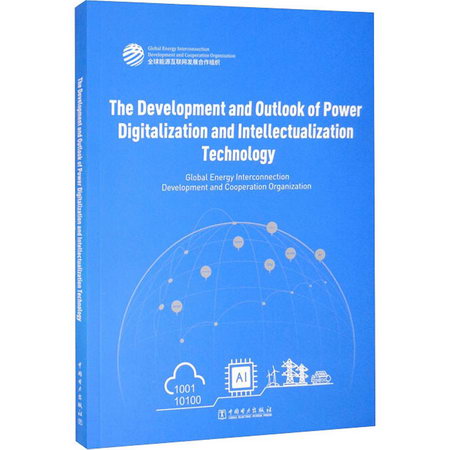| | | | 電力數字智能技術發展與展望 圖書 | | 該商品所屬分類:圖書 -> 水利電力 | | 【市場價】 | 2417-3504元 | | 【優惠價】 | 1511-2190元 | | 【作者】 | 全球能源互聯網發展合作組織 | | 【折扣說明】 | 一次購物滿999元台幣免運費+贈品
一次購物滿2000元台幣95折+免運費+贈品
一次購物滿3000元台幣92折+免運費+贈品
一次購物滿4000元台幣88折+免運費+贈品
| | 【本期贈品】 | ①優質無紡布環保袋,做工棒!②品牌簽字筆 ③品牌手帕紙巾
|
|
| 版本 | 正版全新電子版PDF檔 | | 您已选择: | 正版全新 | 溫馨提示:如果有多種選項,請先選擇再點擊加入購物車。*. 電子圖書價格是0.69折,例如了得網價格是100元,電子書pdf的價格則是69元。
*. 購買電子書不支持貨到付款,購買時選擇atm或者超商、PayPal付款。付款後1-24小時內通過郵件傳輸給您。
*. 如果收到的電子書不滿意,可以聯絡我們退款。謝謝。 | | | |
| | 內容介紹 | |

出版社:中國電力出版社 ISBN:9787519859398 商品編碼:10041467141651 品牌:文軒 出版時間:2021-09-01 代碼:280 作者:全球能源互聯網發展合作組織
" 作 者:全球能源互聯網發展合作組織 著  定 價:280  出 版 社:中國電力出版社  出版日期:2021年09月01日  頁 數:240  裝 幀:平裝  ISBN:9787519859398   ●PREFACE
SUMMARY
1 Development Status and Trend
1.1 Development Status
1.1.1 Dl Technologies Leading Social Change
1.1.2 Dl Technologies are Widely Used in the Power Sector
1.1.3 Electric Power Development Promotes the Progress of DI Technologies
1.2 Situations and Requirements
1.2.1 Requirements for Establishing a New Power System
1.2.2 Requirements for Building a Smart Operation System
1.2.3 Requirements for Collaborative and Integrated Industry Development
1.3 Target Orientation
1.3.1 Smart Upgrade of Power System
1.3.2 Construction of Energy Interconnection Ecology
1.4 Key Technologies
1.4.1 Accurate Sensing - Sensor (Measure) Technology
1.4.2 Information Transmission - Communication Technology
1.4.3 Stable Operation - Control (Protection) Technology
1.4.4 Core Element - Chip Technology
1.4.5 Data Platform - Big Data and Blockchain
1.4.6 Decision Support - Artificial Intelligence
1.5 Summary
2 Sensor (Measure) Technology
2.1 Current Technical Status
2.1.1 History of Development
2.1.2 Current Application
2.2 Main Applications
2.2.1 Measurement of Core Electrical Quantities
2.2.2 Sensing of Operating Status of Power Generation Device
2.2.3 Sensing of Operating Status of Power Transmission Line
2.2.4 Sensing of Operating Status of Transformer Equipment
2.2.5 Sensing of Operating Status of Power Distribution Device
2.2.6 Sensing of Operating Status for Electrical Load
2.3 Key Technologies
2.3.1 MEMS Sensor Technology
2.3.2 Optical Fiber Sensor Technology
2.3.3 Networking Technology for Sensors
2.3.4 Self-energy Extraction Technology
2.4 R&D Direction
2.4.1 Low-cost Integration
2.4.2 Built-in Anti-interference Capability
2.4.3 lti-node Ad Hoc Network
2.4.4 Low Energy Consumption in Self-energy Extraction
2.5 Summary
3 Communication Technology
3.1 Current Technical Status
3.1.1 History of Development
3.1.2 Current Application
3.2 Main Applications
3.2.1 Communication inside Power Generation Plant
3.2.2 Power Communication Network
3.2.3 Communication on User Side
3.3 Key Technologies
3.3.1 Carrier Communication
3.3.2 Optical Fiber Communication
3.3.3 Microwave Communication
3.3.4 Satellite Communication
3.3.5 Bus Communication
3.4 R&D Direction
3.4.1 Larger Capacity
3.4.2 Wider Coverage
3.4.3 Lower Delay
3.4.4 Higher Security
3.5 Summary
4 Control (Protection) Technology
4.1 Current Technical Status
4.1.1 Stage of Classical Control Theory
4.1.2 Stage of Modern Control Theory
4.1.3 Stage of Intelligent Control Theory
4.1.4 Development History of Protection Technology
4.2 Main Applications
4.2.1 Power Plant Control System
4.2.2 Power Grid Dispatching Control
4.2.3 Integrated Substation Automation
4.2.4 Power Demand Control
4.3 Key Technologies
4.3.1 Classical Control
4.3.2 Linear System Control
4.3.3 Nonlinear System Control
4.3.4 System Identification
4.3.5 Fuzzy Logic Control
4.3.6 Neural Network Control
4.3.7 Expert Control
4.3.8 Genetic Algorithm
4.3.9 Wide Area Protection
4.4 B&D Direction
4.4.1 Stochastic Optimal Control
4.4.2 Measurement-ldentification-Control Technology
4.4.3 Wide Area Control Technology
4.4.4 Collaborative Technology Between Protection and Control
4.4.5 System Protection
4.5 Summary
5 Chip Technology
5.1 Current Technical Status
5.1.1 History of Development
5.1.2 Current Application
5.2 Main Applications
5.2.1 Smart Meter
5.2.2 Power Communication
5.2.3 Electricity Safety
5.2.4 Asset Management
5.2.5 Equipment Status Monitoring
5.3 Key Technologies
5.3.1 Low Power Consumption
5.3.2 Design for Reliability
5.3.3 Electromagnetic Protection
5.3.4 Design for Testability
5.3.5 Thermal Simulation
5.4 R&D Direction
5.4.1 Sensor Chips
5.4.2 Communication Chips
5.4.3 Main Control Chip
5.4.4 Secure Chip
5.4.5 Radio Frequency Identification Chip
5.5 Summary
6 Big Data and Blockchain Technology
6.1 Current Technical Status
6.1.1 History of Development
6.1.2 Current Application
6.2 Main Applications
6.2.1 System Operation
6.2.2 Corporate Governance
6.2.3 Market Analysis
6.2.4 Predictive Study
6.2.5 Market Transactions
6.3 Key Technologies
6.3.1 Integration of lti-Source Data
6.3.2 Analysis and Mining
6.3.3 Distributed Storage
6.3.4 Parallel Computing
6.3.5 Visualization
6.3.6 Consensus Algorithm
6.3.7 Asymmetric Cryptographic Algorithm
6.3.8 Peer-to-peer Network Technology
6.3.9 Smart Contract
6.3.10 Other Data Processing Techniques
6.4 R&D Direction
6.4.1 Acquisition and Storage Technology of Big Data
6.4.2 Analysis and Mining Technology of Big Data
6.4.3 Security and Privacy Protection for Big Data
6.4.4 Upgrade of Core Technology of Blockchain
6.5 Summary
7 Artificial Intelligence Technology
7.1 Current Technical Status
7.1.1 History of Development
7.1.2 Current Application
7.2 Main Applications
7.2.1 Source and Load Forecasting
7.2.2 Power Grid Dispatching
7.2.3 Equipment O&M
7.2.4 Electricity Marketing
7.2.5 Planning and Design
7.3 Key Technologies
7.3.1 Machine Learning
7.3.2 Speech Processing
7.3.3 Computer Vision
7.3.4 Intelligent Robot
7.3.5 Biometric ldentification
7.3.6 Expert System
7.4 Development Direction
7.4.1 Swarm Intelligence
7.4.2 Hybrid Enhanced Intelligence
7.4.3 Cognitive Intelligence
7.4.4 Unmanned Intelligence
7.5 Summary
8 Development Prospect
8.1 Development Trend of Technologies
8.2 Prospect of Development Scenario
8.2.1 DI Power System
8.2.2 Intelligent Enterprise Management
8.2.3 "Energy+Information+" Industry
8.2.4 Power Big Data Empowerment
Appendix Abbreviations / Definitions  本報告是《電力數字智能技術發展與展望》的英文版。本報告立足電力數字智能技術的功能定位及發展需求,從技術視角分析了主要關鍵技術的發展現狀、主要應用和研發方向,並就數字智能技術對電力繫統、電力企業、能源產業生態的潛在價值進行了評估。報告分為8章,第1章數字智能技術發展現狀與電力領域的轉型需求出發,分析提出電力數字智能技術的發展目標與定位;第2至7章,分別研究了傳感技術、通信技術、控制技術、芯片技術、大數據與區塊鏈、人工智能等6項關鍵技術;第8章總結了關鍵技術發展趨勢,分別從新型電力繫統構建、智能企業創新管理、“能源+信息+”產業融合發展、電力大數據賦能等4個方面,展望和描繪了電力數字智能技術高度發達的十大典型情景。 
" | | |
| | | | |
|




